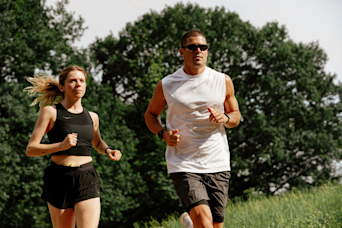Your Basket
Oops! Your basket is empty
Going from a casual morning jog to 26.2 miles can be daunting. From running coaches to former record holders, here are some pieces of insider advice from those who’ve been through it all.
We’re always checking in on our Hueligan community to see how everyone is doing – especially when it comes to what goals they have, and how Huel can help. And one goal that nearly always comes up is running a marathon.
For anyone who’s ever run semi-regularly, it’s the ultimate goal – 26.2 miles of racing, and a true testament to one’s fitness and perseverance.
Now, most marathon training guides will take you through a training plan, how to tailor your nutrition to this plan, and what gear you’re going to need. All of that is valuable information, and we cover those bases here.
But our approach is slightly different. Instead of just repeating what you’ll find elsewhere, we've just gone ahead and asked some of the finest runners around to break down the bits of true insider knowledge they wish they’d known before their first race. This is years worth of marathon running experience broken down into 14 ready-to-go tips. On your marks?
“Easy runs help you recover and build volume in your running week while minimizing the stress on the body and allowing faster recovery from the harder tempo/interval sessions. Instead of chasing a pace, it’s time to switch off and listen to a podcast. You should be running at about 40% effort.”
Anna Ward, manager of Instate London, running coach, and host of ‘Plodcasting’ podcast
“So many marathon runners talk about ‘banking the time’ early in the marathon, meaning they want to get ahead of their pacing schedule. This is a huge mistake. The faster you run, the quicker you deplete your energy bank, meaning you may be forced to slow down or stop.
"This is why so many runners hit the wall; they are forced to slow down due to starting out too fast. Don’t think of it as ‘banking time’ think of it as ‘burning energy too quickly’ and plan appropriately.”
Lewis Moses, former British 1500m champion now INCUS running advisor and lead coach for Runner Retreats.
“More than your smartwatch or your running coach, more than your friends at the run club or the internet, learn to listen to your body. Develop an understanding of how your unique body responds to running, listen to any tight spots and niggles that appear during or after running.”
Paul Coker, lead therapist at Move Physio, NuroKor ambassador, and experienced ultra trail runner.
“Invest in good running shoes that are suited to your running volume, ability, and gait. My preference now is to have a running shoe with good stability for easy and long runs, and then a carbon-plated pair for speed runs and races. Don’t neglect your sock choice, either. Running socks are essential to prevent blisters and make sure your feet stay comfortable.” AW
“Chafing can be a real problem so you must try out your shorts, t-shirt, socks, hat and hydration pack in advance. When it comes to trainers, make sure you have either raced in them before or done your longer training runs in them. Many runners alternate between different types of shoes for different types of training sessions.”
Jordan Matthews, an elite duathlete and triathlete with a 16-minute 5k.
“You are literally trusting a stranger to execute the right race for you, so ask yourself this question; is it your race plan or are you just following the crowd? Pacemakers are told to go out faster, to get more people through the line, but as a result the runners following end up slowing down and dropping off. The best advice as a coach is to stick to your race plan, practice this in training, and trust yourself.” LM
“You don’t need to feed for two the night before. Effective carb loading means gradually increasing the levels of carbohydrates within your normal daily intake of food so that more of the plate is carbs while eating slightly less fats and fiber. You can start thinking about these three to four days out from race day.” AW
“Far more people fail due to a pain problem than a lack of fitness. The most common things that bring marathon runners to a halt are sore spots in places like the achilles tendon, ITB/outer knee, or the lower back/hip area.
"Pain develops gradually in these areas but don’t be that idiot who is a slave to the training program, ignoring a problem until it stops them completely. Maximize your chances of success, listen to your body, and deal with issues early.” PC
“A lot of runners experience gastric issues when training for the marathon. What a lot of runners don’t know is that the gut can be trained. In fact, studies have explored this in detail and one piece of research concluded ‘it seems wise to include training with high-carbohydrate intake into the weekly routine and regularly ingest carbohydrate during exercise.’
"Taking this into consideration, runners should start to practice their fueling in their marathon build-up and do this regularly.” LM
“As wonderful as running is, it is also heavy impact, highly repetitive, hard on your legs but pretty easy on your spine and arms. So just running is never really the smartest plan.
"A couple of non-running exercise sessions a week are a great idea. Leg-strengthening exercises like calf raises, bridges, and squats can really help reduce running-related injuries.” PC
“Humans are made to run. We evolved that way. But we all move and run a little differently, so there is no single right way for a human to run. Don’t try to force any movement, in particular, which bit of your foot hits the ground first. The right way for you to run is going to feel fairly natural and easy - so don’t overthink it.” PC
“Refueling as soon as possible will help you recover faster. I made this mistake when I finished my first marathon. I fueled so much during the event that when I finished, I didn’t want to eat anything. This meant I felt incredibly hungry in the night and felt sick and weak the following day.
"Even if you don’t fancy it, try to force something high in carbohydrates and protein to replenish your stores and help your muscles recover.” JM
“How much fitness you gain from running has as much to do with recovery as it does the run itself. Make sure you are taking care of the basics, get plenty of sleep, eat and hydrate well, particularly in the hours and days after your long run.
"Try to avoid long periods of driving or sitting after long runs. A little gentle movement in the hours after long runs is often helpful to limit DOMs.” PC
“Of course, you need a general idea of the mile pace you ought to be hitting. But a marathon is an opportunity for you to get out of the never-ending stream of thoughts and to-do lists in your head, and focus on your body, your breath, and that unique rhythm that comes from running 26.2 miles. If you’re feeling fatigued, take a 60-second mindful body scan, and bring your attention to your breathing.”
Harriet Le Seve, running coach at harrietlesevept.co.uk
Words: Tom Ward
Get the scoop on exclusive offers and product launches.
This site is protected by reCAPTCHA and the Google Privacy Policy and Terms of Service apply. You can unsubscribe at any time. Huel Privacy Policy.


